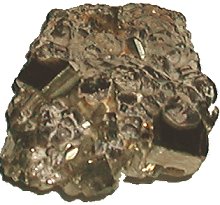
 | New type of 'invisible gold'. Discovery of gold in pyrite dislocations. |
Mining gold is becoming more and more difficult. Mainly because the discovery rate of new gold deposits is declining worldwide. Also the quality of newly discovered gold deposits is often poor. As a result the value of gold has been going up. We have previously mentioned that so-called 'invisible gold' is now becoming a common resource of gold. (June 2019 Editorial). Ores with invisible gold are those which contain trace amounts of gold - predominantly pyrite and arsenopyrite. The largest deposits of invisible gold are in Nevada. Such deposits make up more than 5% of current global gold production and constitute 75% of US gold production. Gold found in pyrites is either structurally bound in the crystal lattice as an alloy or is trapped as discrete metallic particles.
Recent studies from Curtin University have found that gold can also be trapped in pyrite in nanoscale crystal defects also known as dislocations. A dislocation is a linear crystallographic defect or irregularity within a crystal structure that contains an abrupt change in the arrangement of atoms. The movement of dislocations (known as 'glide' or 'slip') allows atoms to slide over each other at low stress levels.
"The more deformed the crystal is, the more gold there is locked up in defects. The gold is hosted in nanoscale defects called dislocations -- one hundred thousand times smaller than the width of a human hair -- so a special technique called atom probe tomography is needed to observe it." said Dr Fougerouse, lead author of a scientific paper on the topic.
Atom probe tomography combines a field ion microscope (a type of microscope that can be used to image the arrangement of atoms at the surface of a sharp metal tip) with a mass spectrometer. As each surface layer is evaporated, the atoms are removed from the specimen allowing the device to probe the material at different depths. The atoms are then analysed by a mass spectrometer. The analysis destroys the sample, but computer methods are used to rebuild a three-dimensional view of the sample prior to it being evaporated, providing atomic scale information on the structure as well as providing information about the type of atomic species.
Once Denis Fougerouse and his colleagues had shown the presence of gold within the pyrite dislocations, the group went on to explore gold extraction methods. As Dr Fougerouse explained:
"We looked into an extraction process called selective leaching, using a fluid to selectively dissolve the gold from the pyrite. Not only do the dislocations trap the gold, but they also behave as fluid pathways that enable the gold to be "leached" without affecting the entire pyrite."
This process requires much less energy than more commonly used pressure oxidizing techniques. (Pressure oxidation is an aqueous process carried out in a continuous autoclave, operating at high pressures and somewhat elevated temperatures.)
Journal Reference:
| _______________________________ | ||||
| Home | | | Shopping | | | Database |
© Biscuit Software 2004-2019
All rights reserved